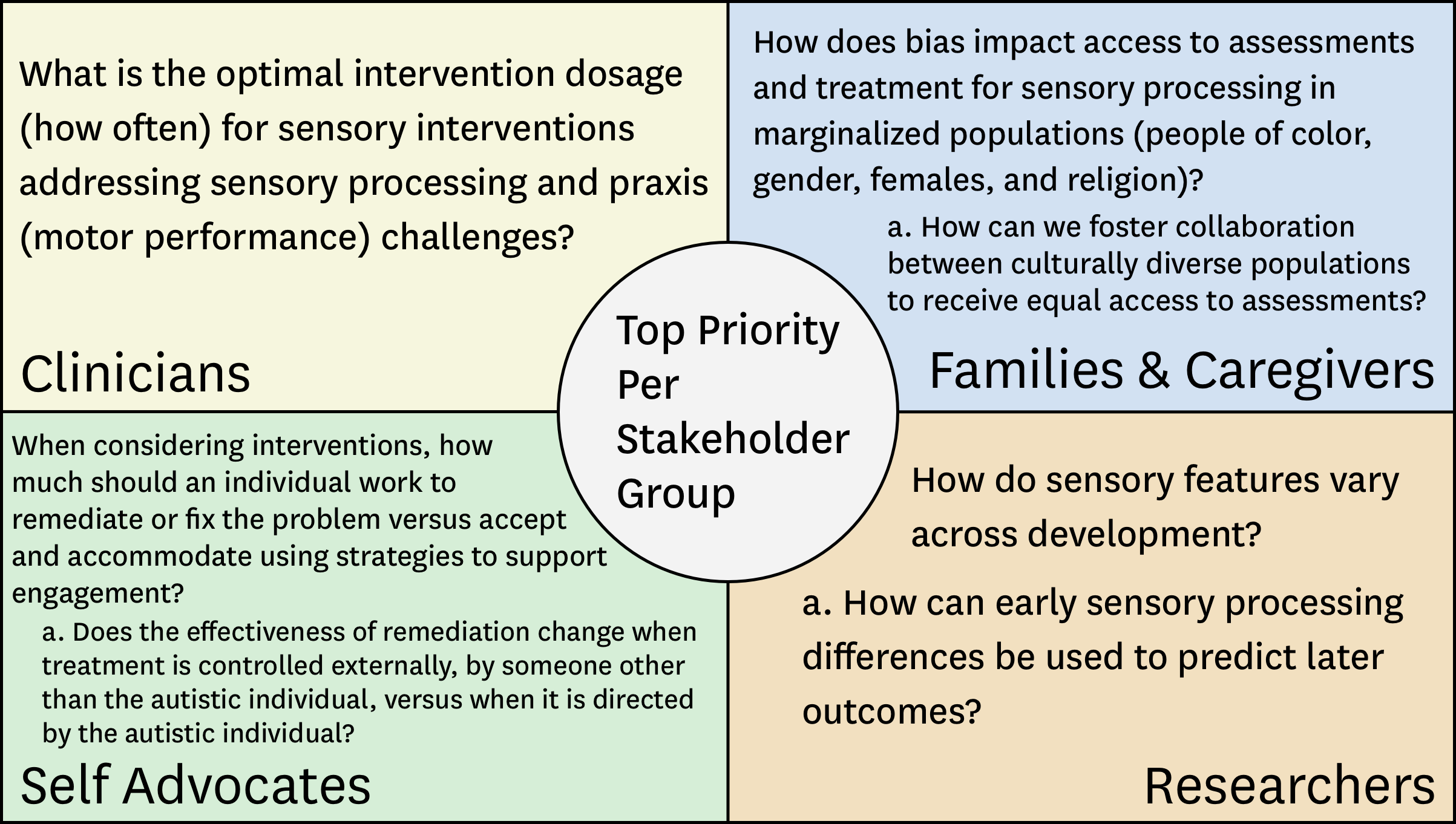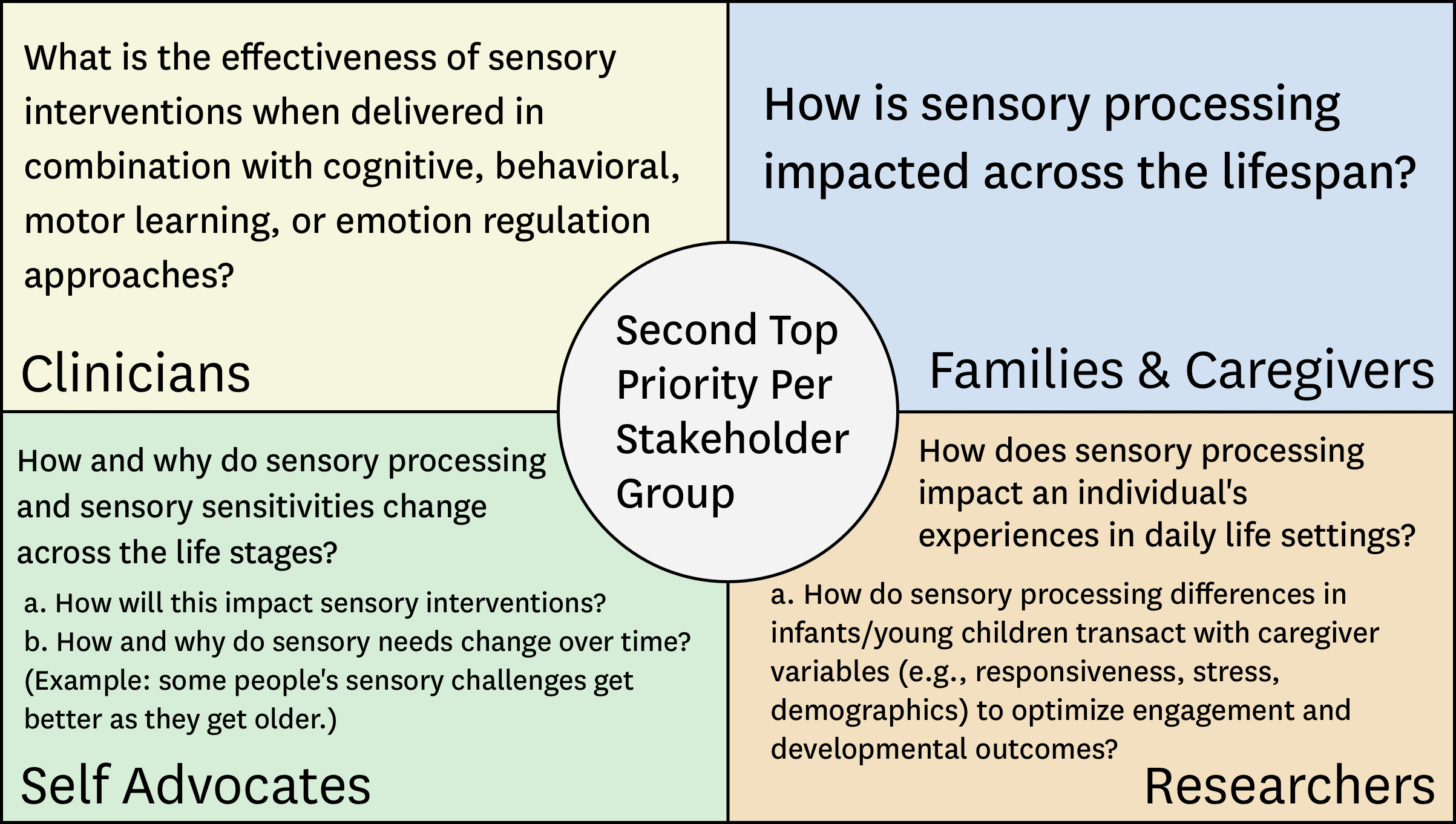TRUST
TRUST Research Priorities
TRUST-Research-Priorities.pdf
This stakeholder engagement project was designed to generate research priorities with the autism community related to sensory processing differences, promote research engagement, and develop resources to facilitate building trust and participation across multiple stakeholder groups. This document summarizes the processes used to develop these priorities and provides both within group and across group recommendations.
Guiding Principles for Research Priorities
In the process of developing research priorities focusing on sensory processing, the group identified core principles for research practices that emphasize inclusivity, representation, and diversity, and acknowledge the centrality of sensory processing to learning, development, sociality, and engagement. The objective for developing these principles is to foster research that seeks to ameliorate (make better or improve) the knowledge gaps that have resulted from sampling strategies that have excluded, or minimally included, sub populations in this heterogeneous community.
Therefore, we are recommending that the following characteristics of the population, key aspects of lived experience, and methodological approaches be incorporated in future research endeavors.
Population
Population characteristics:
- sex and gender (including gender diverse)
- ethnicity and racial identity and intersectionality (overlap of social identities)
- socioeconomic status
- co-occurring and co-morbid conditions
- sensory phenotypes (observable traits)
- cultural and geographic variability
Lived Experiences
Attention to lived experiences should facilitate:
- development of “real life” functional outcomes
- discovery of new phenomena
- understanding of how sensory processing differences are leveraged as strengths
- contributions within family life to sensory processing
- characteristics of contexts and interactions of contextual features, sensory processing, and behavior; and validity of ecological constructs and measures.
Methodological
The following methodological approaches were identified as needing greater consideration:
- longitudinal and change and development across the lifespan
- unobtrusive behavioral and physiological measures
- ecological validity
- knowledge mobilization
- stakeholder engagement
- interrelationships of sensory processing and individual differences
- brain-behavior relationships
- cross system, holistic, and integrated designs
Stakeholder Groups Top Priorities
Top 5 Self Advocate Priorities
- When considering interventions, how much should an individual work to remediate or fix the problem versus accept and accommodate using strategies to support engagement?
- Does the effectiveness of remediation change when treatment is controlled externally, by someone other than the autistic individual, versus when it is directed by the autistic individual?
- How and why do sensory processing and sensory sensitivities change across the life stages?
- How will this impact sensory interventions?
- How and why do sensory needs change over time? (Example: some people’s sensory challenges get better as they get older)
- What are ways to support sensory processing needs through environmental modifications?
- How do autism and sensory processing impact relationships with family members, community, community integration, religious communities, and neighbors?
- Being understood by neurotypical individuals.
- Perceptions and misconceptions of autism.
- Partnerships between autistic and neurotypicals.
- Experience of dating with autism.
- Experience of using augmentative and alternative communication (AAC) device in dating.
- Experience of disclosing that you have autism without feeling threatened.
- How does the presentation of sensory processing needs impact how neurotypical individuals view neurodivergent individuals?
- Ways to improve the process for diagnosing autism and prevent misdiagnosis (Examples: ADHD, PTSD, pain, anxiety, depression, Rhett syndrome).
Top 5 Priorities for the Family and Caregiver Groups
- How does bias impact access to assessments and treatment for sensory processing in marginalized populations (people of color, gender, females, and religion)? How can we foster collaboration between culturally diverse populations to receive equal access to assessments?
- How is sensory processing impacted across the lifespan?
- How can an individual self-manage sensory processing challenges when they are over or under stimulated?
- What strategies can caregivers best utilize to support individuals with sensory processing challenges?
- How can we foster collaboration between home life, school life, and other community settings to provide best practice strategies and techniques that support the individual with sensory processing?
Top 5 Clinician Group Priorities
- What is the optimal intervention dosage for sensory interventions addressing sensory processing and praxis challenges?
- What is the effectiveness of sensory interventions when delivered in combination with cognitive, behavioral, motor learning, or emotion regulation approaches?
- Is there a significant difference in the effectiveness of sensory interventions based on age, race, gender, and severity?
- What is the effectiveness of sensory interventions as compared to cognitive, behavioral, motor learning, or emotion regulation approaches?
- How do we effectively measure changes in sensory processing challenges over time? There is a need to develop quantitative observational tools of sensory processing and praxis that cover the lifespan (including children under 3, adolescents, and adults).
Top 5 Researcher Group Priorities
- How do sensory features vary across development?
- How can early sensory processing differences be used to predict later outcomes?
- What is the precedence of sensory features for later development?
- What are the earliest markers and best methods for early detection of sensory processing differences?
- How do these differences impact developmental domains and functional skills (e.g., social, motor,functional cognition, language, etc.
- How does sensory processing moderate behavior/function and attention/arousal?
- What are the biobehavioral underpinnings of sensory features?
- How can we look at individual differences and trajectories of change within and between individuals?
- How does sensory processing impact an individual’s experiences in daily life settings?
- How do sensory processing differences in infants/young children transact with caregiver variables (e.g., responsiveness, stress, demographics) to optimize engagement and developmental outcomes? (a1) How is this critical in the first months/years of life? (a2) What are protective factors?
- How do sensory processing differences impact education and learning?
- What are the interactions with sensory features and the environment?
- How can we begin to understand the heterogeneity of sensory processing, features, and experience?
- How does sensory processing impact an individual’s experiences in daily life settings?
- How does heterogeneity effect prediction of responses to interventions?
- How to develop understandings of heterogeneity in sensory features and potential subtypes.
- How does heterogeneity impact understanding of developmental outcomes?
- What interventions are effective for addressing sensory processing challenges?
- What Works for whom and under what conditions? (e.g., Ayres Sensory Integration, psycho-pharmaceuticals, behavioral interventions, adaptive and coping strategies)
- What Interventions are effective and developmentally appropriate for adolescents, young adults, and adults?
- What are key ingredients of effective interventions?
- What is the comparative effectiveness of various interventions?
- What dosages/durations are optimal?
- What is the cost effectiveness of these interventions?
- How can new technologies, methods, and environmental modifications be leveraged to create new interventions or enhance existing interventions?
- Diversity of models of intervention delivery (e.g., Parent mediated approaches).
- What are valid ways to measure sensory features?
- How do we quantify sensory features?
- How do we capture self-report and internal environments (i.e., interoception) of sensory experiences in children?
- What is the reliability between self report, caregiver report, and observable measures?
- How can we reconcile our integrate differences across measures?
- How do we disentangle sensory processing from quality of movement and motor skills, arousal, and attention?
- What is the meaning of the sensory behavior to the individual who engages in it?
- Include both strengths and limitations when measuring sensory feature?
Pictorial Representations of Combined Priorities
⋯








